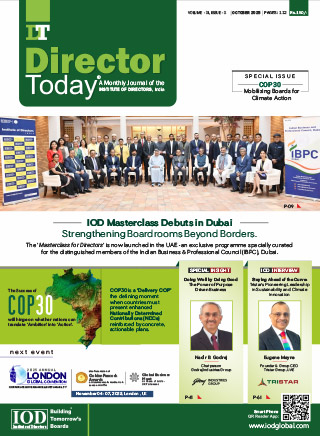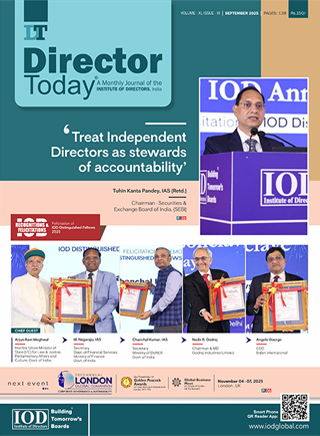Women Directors and Wider Diversity

"The dangers of excessively homogenous boards and the advantages of diversity have long been recognised. As a result of the focus upon greater gender diversity in recent years, have other forms of diversity been overlooked"
Diversity of perspectives, backgrounds and other factors can address groupthink, increase challenge and creativity, make a group of people more representative of the interests they should serve, and contribute to more balanced, equitable, inclusive and socially acceptable outcomes. Diversity, equity and inclusion (DEI) initiatives and roles have been the norm in larger organisations, especially where laws and regulations cover equal opportunities and discrimination in how people are selected, recruited, promoted and treated, and their working conditions. However, in some countries, there has been 'push-back' against practices considered 'ideological' or 'woke', or to have been 'taken too far'. Why is this and what are the implications? Has DEI peaked? Do concerns have substance?
Diversity and DEI initiatives have been criticised for how they have been interpreted and implemented and for their consequences. In the US, President Trump has initiated the elimination of DEI and related roles from government organisations. Major US companies operating internationally are closing their DEI programmes. Critics of DEI argue that given current global risks and pressing existential threats, and in mission critical roles, getting the most competent person is more important and socially beneficial, than achieving a gender or ethnic quota. 'Push back' against diversity and DEI raises questions for boards wishing to 'do the right thing' and operate within the law. Can current requirements for solvency and survival be reconciled with longer-term aspirations for more inclusive outcomes?
Increasingly boards and corporate organisations must do things differently to cope with global risks and threats such as climate change. Yet in many countries prevailing practices have created a relative homogeneity across quoted company boards which can increase the risk of groupthink, and lead to complacency and lack of challenge. In the interests of creativity and innovation, the memberships of many corporate boards may need to become more diverse. What account should a drive for greater diversity take of age, culture, gender, ethnicity, nationality, educational and social backgrounds, experience, skills, personal qualities, interests, perspectives, relationships, priorities, strategies, challenges, opportunities, disability, values or other factors when searching for and selecting directors?
Establishing at Healthy Level of Diversity
Diversity drives should be manageable, and perceived as fair and not too disruptive, if the confidence of investors, family owners and other stakeholders is to be maintained. Beyond a tipping point, a diversity of views, disagreements over purpose and priorities, value disconnects, different attitudes to risk, and divided opinions may become difficult to bridge. Healthy debate may transition to incompatible positions and a fracturing of consensus that prevents decisions without votes and the provision of clear direction to a CEO and executive team. In time those dealing with a company may feel a board has lost control. Diversity to shake up complacency, break up groupthink, and become more inclusive should not be pursued to the extent of creating differences that a chair and social cement cannot handle.
DEI and ESG aspirations, implementation and compliance should take account of stakeholder and wider public expectations and concerns, in the pursuit of responsible, sustainable, and inclusive outcomes, trust and investor confidence. Is a greater variety of diversity and DEI approaches required, to accommodate the differing sizes, nature and locations of enterprises that exist? Might different combinations of diversity factors be required according to situation, circumstances and context?

Should mandatory requirements be extended or reduced? Where exclusion, discrimination and unfairness persists, should diversity be given more attention in discussions of corporate culture and governance?
Diversity and Corporate Boards
Many current boards remain narrow and lacking in diversity. Should more be done to increase the proportion of women company directors, or to widen the gene pool from which directors are selected? What contribution could voluntary or mandatory quotas for women directors make? Are prevailing practices and biases excluding certain groups? Will nomination committees appoint to corporate boards women with family links or similar educational, ethnic and/or social backgrounds to existing directors and with whom they might feel comfortable? Prioritisation of one factor such as gender, can have adverse consequences for other under-represented groups and result in some individuals becoming over boarded.
Greater diversity can result from new appointments to meet emerging issues, challenges and opportunities, such as those relating to the adoption of AI which are being reviewed by legislators and regulators companies as well as many companies. Should different and a wider range of diversity criteria be considered? Might the appropriate combinations of diversity factors to think about change over time and when gaps are identified? It may be possible to simultaneously address multiple diversity requirements when appointments are made, and when undertaking succession planning.
The significance of a particular diversity factor can depend upon the nature and extent of a desired change and who and what could be impacted.
Multiple board members with certain characteristics may be needed before they affect board culture and conduct, corporate performance and/or outcomes. Women directors might have similar educational and social backgrounds to other board members. A critical mass may be required for them to feel less isolated. However, achieving this on multiple diversity criteria, such as age, ethnicity, tribe, caste, language or nationality, might lead to larger boards that are more difficult to manage.
Building More Inclusive and Representative Organisations
Many businesses are not inclusive or representative of communities they serve. Existing boards may not be best placed to provide direction for reaching excluded or under-represented groups. Would younger directors be quicker to recognise the potential of social media and technologies that are more familiar to their age group? In some locations progress has been made in gender diversity, followed by ethnic diversity, and awareness of socio-economic diversity. A direction of travel is evident. While there may be more to do, there are other and pressing matters on board agendas, including global risks and existential threats.
DEI issues remain, as does the need for action in countries where favouritism, nepotism and corruption are endemic. The use of AI and Generative AI tools when short-listing, selecting and promoting can discriminate against excluded, marginalised and other groups that are absent or few and far between in the data that is used to train them. The use of AI trained on historic data may lead to a replication of what already exists. When processes are automated and AI supported, outputs are not critiqued, and cost and time savings are banked rather than used to fund checks and human intervention, people with certain characteristics can be disadvantaged and excluded.
Boards continue to be dependent upon others who may be biased to implement their strategic direction.
More active involvement of people across organisations and their networks of relationships will be required to effectively address the combination of future challenges likely to be faced. An increasing proportion of women directors is linked to a higher proportion of women executives in senior management roles. This can increase gender diversity throughout an organisation and open more routes to the top for female employees. Replicating this outcome with other under-represented factors might create a virtuous spiral of multiple improvements in various parts of future organisations and wider communities.
Handling Wider Diversity
Improving outcomes and addressing existential challenges requires joined up working and thinking, collective responses, and collaboration across business unit, departmental, discipline, entity, functional and national boundaries. Increasing inclusion by involving more parties can result in coordination problems, cause delays, raise costs and the risks of fragmentation, and even lead to disputes. Conscious effort may be required to keep different aspects of DEI in balance. At a certain level in some circumstances, could one have too much of some forms of diversity? Is there an optimum level of diversity, after which diminishing returns might set in as handling it becomes more difficult and negative consequences rise?
Past evidence suggests diverse and inclusive companies may outperform their competitors. Moving beyond cosmetic diversity can present challenges, especially for board chairs and leaders of teams at all levels. Directors are individual human beings who are expected to exercise independent judgement. They are not AI models trained with the same or similar historic data sets. As diversity of approaches, beliefs, perspectives and views increase the challenge may switch from groupthink to the risk of the fragmentation and polarisation that is occurring in wider society. Given insecurity and uncertainty, some stability may aid unity.
People and organisations may 'go along' with DEI when any inconvenience they involve are bearable and manageable. After a time, if economic conditions worsen, they may become more concerned and vocal. Cases may emerge that suggest one group is being unfairly favoured or that discrimination still exists. These may be publicised by interested parties or seized upon by those looking for an issue to champion. Differing views may emerge between those favouring fewer and flexible requirements, and advocates of tighter controls. What was once widely accepted may become an electoral issue, with opposing positions. Might this now happen with diversity and DEI laws and regulations?
Avoiding Throwing Out the Baby with the Bathwater
The dangers of excessively homogenous boards and the advantages of diversity have long been recognised. As a result of the focus upon greater gender diversity in recent years, have other forms of diversity been overlooked? Is insufficient attention given to age, cultural, disability, educational, ethnic, nationality, perspective, political, religious, social, thinking and other diversity considerations, criteria and factors? The challenges, opportunities and existential and other risks in the contexts in which many companies operate are evolving, often unfamiliar and becoming more pressing. What qualities are needed to address them?
Priority diversity factors may need to be those most conducive of fluidity, openness and resilience in the face of uncertainty, instability and volatility, and corporate and collective action in response to common challenges and shared and inter-related existential threats such as global warming and climate change. Rather than address discrete problems, future leaders will be required to ensure relevant diversity for handling evolving and inter-related issues, maintaining commitment and collaboration, and ensuring effective collective responses.
How should boards respond to concerns about DEI laws and regulations? Do current provisions help some at the cost of fewer opportunities for others and financial and administrative burdens on employers? Should DEI laws and regulations be more flexible, less prescriptive, and/or allow reasonable exceptions? Are there roles for which the most competent person should be appointed regardless of diversity considerations? Should guidance replace mandated requirements, or might loosening and backsliding disadvantage those whom diversity and DEI laws and regulations have sought to protect?
Author

Prof. Colin Coulson-Thomas
Director-General of IOD India for UK and Europe operations
Prof. (Dr) Colin Coulson-Thomas, President of the Institute of Management Services and Director-General of IOD India for UK and Europe operations. He has advised directors and boards in over 40 countries.
Owned by: Institute of Directors, India
Disclaimer: The opinions expressed in the articles/ stories are the personal opinions of the author. IOD/ Editor is not responsible for the accuracy, completeness, suitability, or validity of any information in those articles. The information, facts or opinions expressed in the articles/ speeches do not reflect the views of IOD/ Editor and IOD/ Editor does not assume any responsibility or liability for the same.

 Quick Links
Quick Links
 Connect us
Connect us




 Back to Home
Back to Home






























